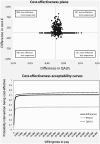Cost-effectiveness of a community pharmacist intervention in patients with depression: a randomized controlled trial (PRODEFAR Study)
- PMID: 23950967
- PMCID: PMC3741197
- DOI: 10.1371/journal.pone.0070588
Cost-effectiveness of a community pharmacist intervention in patients with depression: a randomized controlled trial (PRODEFAR Study)
Erratum in
-
Correction: Cost-Effectiveness of a Community Pharmacist Intervention in Patients with Depression: A Randomized Controlled Trial (PRODEFAR Study).PLoS One. 2016 Jan 14;11(1):e0147459. doi: 10.1371/journal.pone.0147459. eCollection 2016. PLoS One. 2016. PMID: 26765519 Free PMC article. No abstract available.
Abstract
Background: Non-adherence to antidepressants generates higher costs for the treatment of depression. Little is known about the cost-effectiveness of pharmacist's interventions aimed at improving adherence to antidepressants. The study aimed to evaluate the cost-effectiveness of a community pharmacist intervention in comparison with usual care in depressed patients initiating treatment with antidepressants in primary care.
Methods: Patients were recruited by general practitioners and randomized to community pharmacist intervention (87) that received an educational intervention and usual care (92). Adherence to antidepressants, clinical symptoms, Quality-Adjusted Life-Years (QALYs), use of healthcare services and productivity losses were measured at baseline, 3 and 6 months.
Results: There were no significant differences between groups in costs or effects. From a societal perspective, the incremental cost-effectiveness ratio (ICER) for the community pharmacist intervention compared with usual care was €1,866 for extra adherent patient and €9,872 per extra QALY. In terms of remission of depressive symptoms, the usual care dominated the community pharmacist intervention. If willingness to pay (WTP) is €30,000 per extra adherent patient, remission of symptoms or QALYs, the probability of the community pharmacist intervention being cost-effective was 0.71, 0.46 and 0.75, respectively (societal perspective). From a healthcare perspective, the probability of the community pharmacist intervention being cost-effective in terms of adherence, QALYs and remission was of 0.71, 0.76 and 0.46, respectively, if WTP is €30,000.
Conclusion: A brief community pharmacist intervention addressed to depressed patients initiating antidepressant treatment showed a probability of being cost-effective of 0.71 and 0.75 in terms of improvement of adherence and QALYs, respectively, when compared to usual care. Regular implementation of the community pharmacist intervention is not recommended.
Trial registration: ClinicalTrials.gov NCT00794196.
Conflict of interest statement
Figures


References
-
- Alonso J, Angermeyer MC, Bernert S, Bruffaerts R, Brugha TS, et al. (2004) Prevalence of mental disorders in Europe: results from the European Study of the Epidemiology of Mental Disorders (ESEMeD) project. Acta Psychiatr Scand Suppl: 21–27. - PubMed
-
- Mathers CD, Loncar D (2006) Projections of global mortality and burden of disease from 2002 to 2030. PLoS Med 3: e442 Available: http://www.plosmedicine.org/article/info%3Adoi%2F10.1371%2Fjournal.pmed..... - PMC - PubMed
-
- Sturm R, Wells KB (1995) How can care for depression become more cost-effective? JAMA 273: 51–58. - PubMed
-
- Sobocki P, Jonsson B, Angst J, Rehnberg C (2006) Cost of depression in Europe. J Ment Health Policy Econ 9: 87–98. - PubMed
-
- Commission of the European Communities (2005) Green Paper. Improving the mental health of the population. Towards a strategy on mental health for the European Union. Brussels.
Publication types
MeSH terms
Substances
Associated data
LinkOut - more resources
Full Text Sources
Other Literature Sources
Medical

